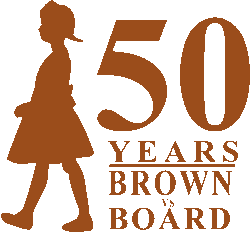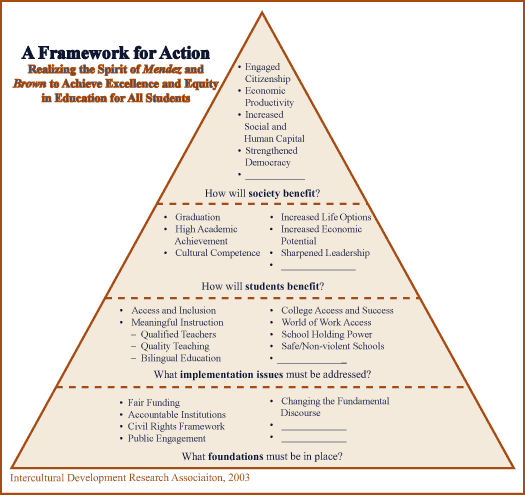• by Bradley Scott , Ph.D. • IDRA Newsletter • May 2004 • 

There has been a flurry of activity around the 50th anniversary of the landmark ruling made by the U.S. Supreme Court in Brown vs. the Board of Education of Topeka, Kansas in 1954. There have been many local and national events that have taken place, including a unique event sponsored by the Intercultural Development Research Association (IDRA) in October 2003 see related web site. IDRA and the other nine equity assistance centers are excited about these events for three important reasons.


The first is the fact that commemorating the Brown ruling allows us, as a nation, to reflect on who we were and the distances we have had to travel to fight racism and all of its ugliest forms of discrimination to acknowledge that separate schooling is inherently unequal.
In this first instance, the excitement involves the fact that many segments of society, including civic, political, education, religious, and business, are pausing to acknowledge Brown and what it has meant as a historical marker for the United States. The ruling created a societal shift, the effects of which are still being experienced to this very moment.
A second important reason for our excitement speaks to where we are after 50 years of labor to create unitary schools systems where every child is afforded an equal educational opportunity and is not denied this opportunity because of his or her race, color, or national origin. The issue here is that while there have been many improvements in public education, the promise of Brown has not yet been fulfilled.
Robledo Montecel (2003) and others (Orfield and Chungmei, 2004; Cortez and Robledo Montecel, 2004) describe many ways in which the promise of equal educational opportunity still eludes us in practice even though the laws are essentially in place. One might almost believe that the duality and separateness of public education by race and class are an endemic part of our national nature.
If race and class are such strong determiners of one’s access to quality education, it is sad at best and tragic at worst, but nonetheless absolutely critical for the legally-mandated work of the equity assistance centers to continue.
The equity assistance centers find their origin in Title IV the Civil Rights Act of 1964. They are the oldest technical assistance entity specifically created to provide technical assistance, including training to public school systems that are desegregating and working to become unitary in the spirit of the Brown ruling. Regardless of their name or structure over the 40 years of their existence, it is they who have sounded the call for equal educational opportunity in public education, equity in access and treatment in public schools, and excellence for all learners regardless of race, gender, or national origin whether the call was to improve America’s schools or to “leave no child behind” (Scott, 1999; Scott, 2000; Scott, 2002).
In this final instance, the excitement experienced by the equity assistance centers rests not in whom we have been or even where we are.
The real excitement rests in who we can be as a nation if we strengthen our public schools, if we keep the public talking about quality, excellent education for learners no matter where they live and who they are.
The equity centers designed a plan for action that will be presented at a conference in New York City at New York University. The theme of the conference is: Brown Plus 50: A Renewed Agenda for Social Justice. One of the sessions conducted by Dr. Bradley Scott of the IDRA South Central Collaborative for Equity and Dr. Joan Dawson of the Metro Center equity assistance center, is entitled: The Equity Assistance Centers – Taking Brown from the Court Room to the Classroom.
This presentation will expand upon a framework originally created by IDRA for the Mendez (1946) and Brown (1954) event that was held in San Antonio a few months ago. The framework identifies certain critical foundational and implementation issues that must be addressed for the spirit of Brown to work for all learners in public schools.
In fact, the framework clearly challenges stakeholders to understand that for students and the nation to benefit, quality, equitable educational opportunity can only be created through intensive and extensive work to address critical identified foundational and implementation issues (see box below).
It may be necessary to ask ourselves how serious we were as a nation when the original Brown decision was rendered in 1954. It is certainly important to assess how serious we are now in an era of No Child Left Behind. It is probably most important to determine who we truly see ourselves being as this century continues to unfold. It is certain that many of the old answers we have created that have left many learners under-served, inadequately educated, and poorly prepared for life success will not serve our collective best interest if we honestly plan to leave no child behind.
Suddenly, it seems that the real question individual stakeholders need to ask themselves is on what side of the Brown ruling they stand. Where we stand makes a world of difference as to how we will address the questions raised in the framework. Position is everything.


Resources
Cortez, A., and M. Robledo Montecel. “Texas at a Crossroads Excellent and Equitable Schools – or Merely Adequate,” IDRA Newsletter (San Antonio, Texas: Intercultural Development Research Association, February 2004).
Orfield, G., and L. Chungmei. Brown at 50: King’s Dream or Plessy’s Nightmare (Cambridge, Mass.: The Civil Rights Project: Harvard University, January 2004).
Robledo Montecel, M. “Fulfilling the Promise of Brown vs. Board of Education,” IDRA Newsletter (San Antonio, Texas: Intercultural Development Research Association, November-December 2003).
Scott, B. “Who’s Responsible, Who’s to Blame?” IDRA Newsletter (San Antonio, Texas: Intercultural Development Research Association, May 2002).
Scott, B., and J.D. Cortez. “Equity Challenges Continue,” IDRA Newsletter (San Antonio, Texas: Intercultural Development Research Association, September 2000).
Scott, B. “From ‘DAC’ to ‘EAC’ – The Expanding Role of the Equity Assistance Center,” IDRA Newsletter (San Antonio, Texas: Intercultural Development Research Association, February 1999).
Bradley Scott, Ph.D., is a senior education associate in the IDRA Division of Professional Development. Comments and questions may be directed to him via e-mail at feedback@idra.org.
[©2004, IDRA. This article originally appeared in the May 2004 IDRA Newsletter by the Intercultural Development Research Association. Permission to reproduce this article is granted provided the article is reprinted in its entirety and proper credit is given to IDRA and the author.]


